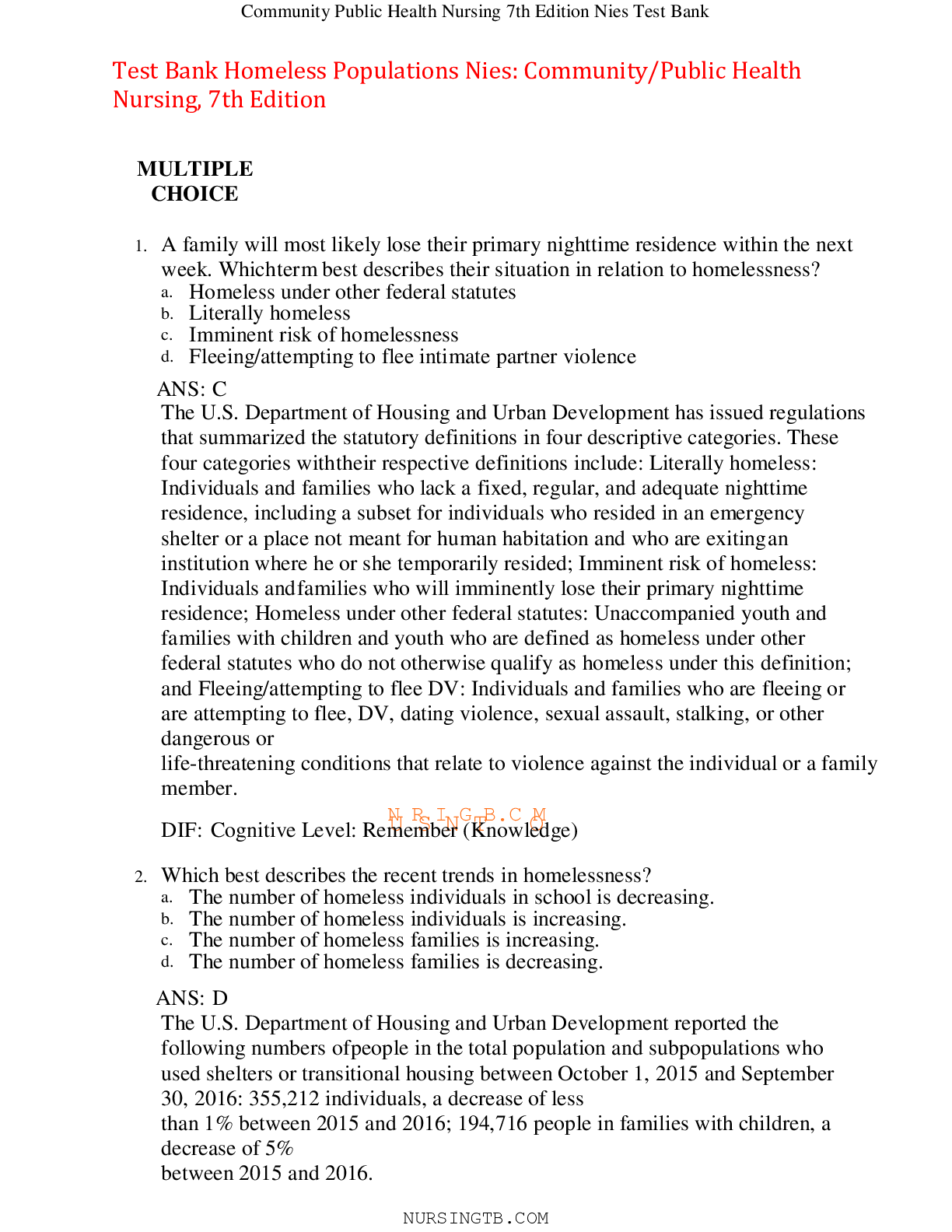*NURSING > TEST BANK > Chapter 46: Care of Patients with Problems of the Peripheral Nervous System Test Bank,100% CORRECT (All)
Chapter 46: Care of Patients with Problems of the Peripheral Nervous System Test Bank,100% CORRECT
Document Content and Description Below
Chapter 46: Care of Patients with Problems of the Peripheral Nervous System Test Bank MULTIPLE CHOICE 1. The nurse recognizes which pathophysiologic feature as a hallmark of Guillain-Barré sy... ndrome? a. Nerve impulses are not transmitted to skeletal muscle. b. The immune system destroys the myelin sheath. c. The distal nerves degenerate and retract. d. Antibodies to acetylcholine receptor sites develop. ANS: B In Guillain-Barré syndrome, the immune system destroys the myelin sheath, causing segmental demyelination. Nerve impulses are transmitted more slowly but remain in place. Antibodies are not developed. The nerves do not degenerate and retract. DIF: Cognitive Level: Knowledge/Remembering REF: p. 987 TOP: Client Needs Category: Physiological Integrity (Physiological Adaptation—Pathophysiology) MSC: Integrated Process: Nursing Process (Assessment) 2. The nurse assesses a client who has Guillain-Barré syndrome. Which clinical manifestation does the nurse expect to find in this client? a. Ophthalmoplegia and diplopia b. Progressive weakness without sensory involvement c. Progressive, ascending weakness and paresthesia d. Weakness of the face, jaw, and sternocleidomastoid muscles ANS: C The most common clinical pattern of Guillain-Barré syndrome is the ascending variety. Weakness and paresthesia begin in the lower extremities and progress upward. The other manifestations are not associated with Guillain-Barré syndrome. DIF: Cognitive Level: Comprehension/Understanding REF: p. 987 TOP: Client Needs Category: Physiological Integrity (Physiological Adaptation—Pathophysiology) MSC: Integrated Process: Nursing Process (Assessment) 3. The nurse reviews laboratory data for a client who has Guillain-Barré syndrome (GBS). Which result does the nurse correlate with this disease process? a. Increased cerebrospinal fluid (CSF) protein level b. Decreased serum protein electrophoresis results c. Increased antinuclear antibodies d. Decreased immune globulin G (IgG) levels ANS: A A lumbar puncture is performed to evaluate the CSF. An increased CSF protein level without increased cell count is a distinguishing feature of GBS. The other results are not associated with GBS. DIF: Cognitive Level: Comprehension/Understanding REF: p. 988 TOP: Client Needs Category: Physiological Integrity (Physiological Adaptation—Pathophysiology) MSC: Integrated Process: Nursing Process (Assessment) 4. The intensive care nurse is caring for a client who has Guillain-Barré syndrome. The nurse notes that the client’s vital capacity has declined to 12 mL/kg, and the client is having difficulty clearing secretions. Which is the nurse’s priority action? a. Place the client in a high Fowler’s position. b. Prepare the client for elective intubation. c. Administer oxygen via a nasal cannula. d. Auscultate for breath sounds. ANS: B Deterioration in vital capacity to less than 15 mL/kg and an inability to clear secretions are indications for elective intubation. The other interventions may assist with breathing and oxygenation but would not reverse the deterioration in vital capacity or help clear secretions. DIF: Cognitive Level: Application/Applying or higher REF: N/A TOP: Client Needs Category: Physiological Integrity (Reduction of Risk Potential—Potential for Complications from Surgical Procedures and Health Alterations) MSC: Integrated Process: Nursing Process (Implementation) 5. A client who has Guillain-Barré syndrome is scheduled for plasmapheresis. Before the procedure, which clinical manifestation does the nurse use to determine patency of the client’s arteriovenous shunt? a. Palpable distal pulses b. A pink, warm extremity c. The presence of a bruit d. Shunt pressure higher than 25 mm Hg ANS: C Nursing care of the client undergoing plasmapheresis includes care of the shunt. The nurse checks for bruits every 2 to 4 hours for patency. Pulse and extremity assessments do not provide information related to shunt patency. Pressure within the shunt is not tested before treatment to determine patency. DIF: Cognitive Level: Application/Applying or higher REF: N/A TOP: Client Needs Category: Physiological Integrity (Reduction of Risk Potential—Therapeutic Procedures) MSC: Integrated Process: Nursing Process (Implementation) 6. The nurse assesses a client with Guillain-Barré syndrome during plasmapheresis. Which complication does the nurse monitor for during this procedure? a. Tachycardia b. Hypovolemia c. Hyperkalemia d. Hemorrhage ANS: B The client undergoing plasmapheresis is at risk for hypovolemia. The nurse monitors fluid status, assesses vital signs, and administers replacement fluid, as indicated. The other manifestations are not complications of plasmapheresis. DIF: Cognitive Level: Application/Applying or higher REF: N/A TOP: Client Needs Category: Physiological Integrity (Reduction of Risk Potential—Potential for Complications from Diagnostic Tests/Treatments/Procedures) MSC: Integrated Process: Nursing Process (Implementation) 7. The nurse teaches a client with Guillain-Barré syndrome (GBS) about the recovery rate of this disorder. Which statement indicates that the client correctly understands the teaching? a. “I need to see a lawyer because I do not expect to recover from this disease.” b. “I will have to take things slowly for several months after I leave the hospital.” c. “I expect to be able to return to work in construction soon after I get discharged.” d. “I wonder if my family will be able to manage my care now that I am paralyzed.” ANS: B Most clients make a full recovery from GBS. Recovery can take as long as 6 months to 2 years. Fatigue is a major lingering symptom for most of those diagnosed with this disorder. Clients are not permanently paralyzed. They are in an acute care environment during the acute phase of the disorder. DIF: Cognitive Level: Application/Applying or higher REF: N/A TOP: Client Needs Category: Psychosocial Integrity (Stress Management) MSC: Integrated Process: Teaching/Learning 8. The nurse assesses a client who has myasthenia gravis. Which clinical manifestation does the nurse expect to observe in this client? a. Inability to perform the six cardinal positions of gaze b. Lateralization to the affected side during the Weber test c. Absent deep tendon reflexes d. Impaired stereognosis ANS: A The most common assessment finding in more than 90% of clients with myasthenia gravis is involvement of the extraocular muscles. The nurse observes for inability or difficulty with tests of extraocular function, such as the cardinal positions of gaze. Ptosis and incomplete eye closure also may be observed. Altered hearing and absent reflexes are not common in myasthenia gravis. DIF: Cognitive Level: Comprehension/Understanding REF: p. 991 TOP: Client Needs Category: Physiological Integrity (Physiological Adaptation—Pathophysiology) MSC: Integrated Process: Nursing Process (Assessment) 9. The nurse is assessing laboratory results for a client with myasthenia gravis (MG). Which results does the nurse correlate with this disease process? a. Elevated serum calcium level b. Decreased thyroid hormone level c. Decreased complete blood count d. Elevated acetylcholine receptor antibody levels ANS: D Testing for acetylcholine receptor (AChR) antibodies is important because 80% to 90% of clients with the disease have elevated AChR antibody levels. The other laboratory results are not associated with myasthenia gravis. DIF: Cognitive Level: Comprehension/Understanding REF: p. 992 TOP: Client Needs Category: Physiological Integrity (Physiological Adaptation—Pathophysiology) MSC: Integrated Process: Nursing Process (Assessment) 10. A client suspected to have myasthenia gravis is scheduled for the Tensilon (edrophonium chloride) test. Which prescribed medication does the nurse prepare to administer if complications of this test occur? a. Epinephrine b. Atropine sulfate c. Diphenhydramine d. Neostigmine bromide ANS: B Tensilon increases cholinergic responses and can slow the heart rate down so that ectopic beats dominate, causing cardiac fibrillation or arrest. Atropine sulfate is an anticholinergic drug. The other medications are not appropriate for complications of this test. DIF: Cognitive Level: Application/Applying or higher REF: N/A TOP: Client Needs Category: Physiological Integrity (Reduction of Risk Potential—Potential for Complications from Diagnostic Tests/Treatments/Procedures) MSC: Integrated Process: Nursing Process (Implementation) 11. The nurse is caring for a client who has myasthenia gravis. Which nursing intervention does the nurse implement to reduce muscle weakness in this client? a. Administer a therapeutic massage. b. Collaborate with the physical therapist. c. Perform passive range-of-motion exercises. d. Reposition the client every 2 hours. ANS: B The hallmark of myasthenia gravis is muscle weakness that increases with fatigue. The nurse provides assistance with ADLs to prevent fatigue. The nurse collaborates with the physical therapist in teaching the client energy conservation techniques. Therapeutic massage, passive range of motion, and repositioning will not reduce muscle weakness. DIF: Cognitive Level: Application/Applying or higher REF: N/A TOP: Client Needs Category: Physiological Integrity (Physiological Adaptation—Illness Management) MSC: Integrated Process: Nursing Process (Implementation) 12. The nurse is assessing a client who is experiencing a myasthenia crisis. Which diagnostic test does the nurse anticipate being ordered? a. Babinski reflex test b. Tensilon test c. Cholinesterase challenge test d. Caloric reflex test ANS: B The Tensilon test in an important procedure for a client in myasthenic crisis. Cholinesterase- inhibiting drugs should be withheld because they increase respiratory secretions, which enhance the manifestations of a myasthenic crisis. A Babinski reflex and caloric reflex test would not be appropriate for this client. DIF: Cognitive Level: Knowledge/Remembering REF: p. 992 TOP: Client Needs Category: Physiological Integrity (Physiological Adaptation—Illness Management) MSC: Integrated Process: Nursing Process (Analysis) 13. A client who has myasthenia gravis is receiving atropine for a cholinergic crisis. Which intervention does the nurse implement for this client? a. Suction the client to remove secretions. b. Turn and reposition the client every 2 hours. c. Measure urinary output every 30 minutes. d. Administer prescribed anticholinergic drugs as needed. ANS: A Atropine can cause thickening of secretions and formation of mucous plugs. The client is maintained on a ventilator during the crisis. Measures to remove secretions to prevent the buildup of secretions and the possibility of pneumonia are most important. The other interventions do not relate to the administration of atropine. DIF: Cognitive Level: Application/Applying or higher REF: N/A TOP: Client Needs Category: Physiological Integrity (Pharmacological and Parenteral Therapies— Adverse Effects/Contraindications/Side Effects/Interactions) MSC: Integrated Process: Nursing Process (Implementation) 14. The nurse instructs a client who has myasthenia gravis to take prescribed medications on time and to eat meals 45 to 60 minutes after taking anticholinesterase drugs. The client asks why the timing of meals is so important. Which is the nurse’s best response? a. “This timing allows the drug to have maximum effect, so it is easier for you to chew, swallow, and not choke.” b. “This timing prevents your blood sugar level from dropping too low and causing you to be at risk for falling.” c. “These drugs are very irritating to your stomach and could cause ulcers if taken too long before meals.” d. “These drugs cause nausea and vomiting. By waiting a while after you take the medication, you are less likely to vomit.” ANS: A Skeletal muscle weakness extends to the ability to chew and swallow. Clients who have myasthenia gravis are at risk for aspiration during meals. Timing the medication so that most of the meal is eaten when the drugs have produced their peak effect enables the client to chew and swallow more easily. The medication has no effect on blood glucose levels, ulcers, or nausea. DIF: Cognitive Level: Application/Applying or higher REF: N/A TOP: Client Needs Category: Health Promotion and Maintenance (Self-Care) MSC: Integrated Process: Teaching/Learning 15. A client who has myasthenia gravis is recovering after a thymectomy. Which complication does the nurse monitor for in this client? a. Sudden onset of shortness of breath b. Swelling of the lower extremities c. Lower abdominal tenderness d. Decreased urinary output ANS: A The complication to be alert for is pneumothorax or hemothorax. The nurse monitors the client for chest pain, sudden onset of shortness of breath, diminished chest wall expansion, decreased breath sounds, restlessness, and changes in vital signs. The other symptoms are not likely to occur or are not related to removal of the thymus. DIF: Cognitive Level: Application/Applying or higher REF: N/A TOP: Client Needs Category: Physiological Integrity (Reduction of Risk Potential—Potential for Complications from Surgical Procedures and Health Alterations) MSC: Integrated Process: Nursing Process (Assessment) 16. A client with myasthenia gravis is preparing for discharge. Which instructions does the nurse include when educating the client’s family members or caregiver? a. Technique for therapeutic massage to the lower extremities b. Administration of morphine sulfate via an IV pump c. Instructions for preparing thin, puréed foods d. Cardiopulmonary resuscitation (CPR) ANS: D Respiratory compromise is a common occurrence with myasthenia gravis. The client’s family members are encouraged to learn CPR and to have resuscitation equipment available in the home. The other interventions are not a priority. DIF: Cognitive Level: Application/Applying or higher REF: N/A TOP: Client Needs Category: Physiological Integrity (Reduction of Risk Potential—Potential for Complications from Surgical Procedures and Health Alterations) MSC: Integrated Process: Teaching/Learning 17. The nurse teaches a client who has autonomic dysfunction about injury prevention. Which statement indicates that the client correctly understands the teaching? a. “I will change positions slowly.” b. “I will avoid wearing cotton socks.” c. “I will use an electric razor.” d. “I will use a heating pad on my feet.” ANS: A Autonomic dysfunction causes orthostatic hypotension. The client should change positions slowly to prevent orthostatic hypotension. Autonomic dysfunction can cause peripheral polyneuropathy, so the client should be taught to wear socks and shoes at all times and not to use a heating pad. The disorder does not cause bleeding; therefore the client can use any type of razor. DIF: Cognitive Level: Application/Applying or higher REF: N/A TOP: Client Needs Category: Physiological Integrity (Reduction of Risk Potential—Potential for Complications from Surgical Procedures and Health Alterations) MSC: Integrated Process: Nursing Process (Evaluation) 18. The nurse is planning discharge teaching for a client who has peripheral neuropathy of the lower extremities. Which instruction does the nurse include in the teaching plan? a. “Cut all calluses and corns from your feet as soon as you notice them.” b. “Your balance will be steadier if you go barefoot while at home.” c. “Use a thermometer to check the temperature of bath water.” d. “Avoid using lotion on the feet and legs.” ANS: C The client with neuropathy has loss of sensation in the lower extremities, which can predispose the client to thermal injury. The client should be instructed to use a thermometer to check the temperature of the bath water to avoid a burn. Checking the water with the hands is not recommended because neuropathy may have a stocking and glove distribution that could also affect the hands. The client should be taught to wear shoes at all times, to assess feet and legs daily, to keep skin moist and clean, and not to cut calluses or corns from the feet. DIF: Cognitive Level: Application/Applying or higher REF: N/A TOP: Client Needs Category: Physiological Integrity (Reduction of Risk Potential—Potential for Complications from Surgical Procedures and Health Alterations) MSC: Integrated Process: Teaching/Learning 19. The nurse is caring for a client who has undergone peripheral nerve repair. Which priority assessment does the nurse perform postoperatively? a. Evaluate extremity mobility. b. Assess the skin surrounding the cast. c. Test distal extremities for sensation. d. Auscultate bowel sounds. ANS: B The nurse assesses the skin surrounding the cast hourly for tightness, warmth, and color. If the cast is too tight, the nurse notifies the provider immediately. The other assessments should be completed after a circulatory assessment. DIF: Cognitive Level: Application/Applying or higher REF: N/A TOP: Client Needs Category: Physiological Integrity (Reduction of Risk Potential—Potential for Complications from Surgical Procedures and Health Alterations) MSC: Integrated Process: Nursing Process (Assessment) 20. The nurse is assessing a client with trigeminal neuralgia. Which clinical manifestation does the nurse expect to observe? a. Excruciating pain b. Decreased mobility c. Controllable facial twitching d. Increased talkativeness ANS: C Signs of trigeminal neuralgia are excruciating pain and uncontrollable facial twitching which causes the client to avoid talking, smiling, eating, or attending to hygienic needs. Sensory and mobility deficits are not associated with trigeminal neuralgia. DIF: Cognitive Level: Knowledge/Remembering REF: p. 1000 TOP: Client Needs Category: Physiological Integrity (Physiological Adaptation—Alterations in Body Systems) MSC: Integrated Process: Nursing Process (Assessment) 21. The nurse is assessing a client who had a dissection of all branches of the right trigeminal nerve. When asked to wrinkle his forehead, the client wrinkles only the left side. Which is the nurse’s best action? a. Place the client in high Fowler’s position. b. Document the finding. c. Assess the corneal reflex. d. Notify the health care provider. ANS: B Loss of motor and sensory function after complete trigeminal nerve dissection is normal. No intervention is necessary. DIF: Cognitive Level: Application/Applying or higher REF: N/A TOP: Client Needs Category: Physiological Integrity (Physiological Adaptation—Pathophysiology) MSC: Integrated Process: Nursing Process (Assessment) 22. A client with trigeminal neuralgia is about to undergo surgery for pain relief. The client asks, “How will this surgery relieve my pain?” How does the nurse respond? a. “The surgeon will cut the connection between the cranial nerves.” b. “The surgeon will use an electrode to bypass the trigeminal nerve conduction.” c. “An incision is made into the nerve itself, and an anesthetic is applied to the area.” d. “A small artery compressing the nerve will be relocated.” ANS: D In some clients, a small artery compresses the nerve as it enters the pons. By relocating this nerve, pain relief is obtained and sensation is spared. The other responses do not answer the client’s question appropriately. DIF: Cognitive Level: Application/Applying or higher REF: N/A TOP: Client Needs Category: Physiological Integrity (Physiological Adaptation—Illness Management) MSC: Integrated Process: Teaching/Learning 23. The nurse is teaching a client who is receiving carbamazepine (Tegretol) for chronic trigeminal neuralgia. Which statement indicates that the client correctly understands the teaching? a. “This drug will prevent seizures, which can occur because of trigeminal disease.” b. “I expect to have surgery soon, so I can stop taking this drug now.” c. “This medication is very successful in relieving pain. I am glad to be taking it.” d. “I will avoid drinking alcohol because it can add to the side effects of this medicine.” ANS: D Carbamazepine is thought to interfere with the transmission of pain through slow fibers. It may decrease the paroxysmal afferent impulse that causes trigeminal pain. Trigeminal disease does not cause seizures. Drowsiness, dizziness, confusion, and risk for falls are adverse effects of this medication. Alcohol consumption increases these risks; therefore the client should not drink alcohol when taking this medication. Seizure disorders may occur in clients who stop taking this medication. The dose should be decreased gradually. Pain relief varies with the person; some people find that this medication provides at least some relief. DIF: Cognitive Level: Application/Applying or higher REF: N/A TOP: Client Needs Category: Health Promotion and Maintenance (Self-Care) MSC: Integrated Process: Nursing Process (Evaluation) 24. The nurse teaches a client who has Guillain-Barré syndrome (GBS) about pain management. Which statement indicates that the client correctly understands the teaching? a. “I can use the button on the pump as often as I want to get more pain medication.” b. “Aspirin will provide the best relief from my pain associated with this disease.” c. “A combination of morphine and distraction helps bring me relief right now.” d. “I should not have any pain as a result of impaired motor and sensory neurons.” ANS: C Typical pain from GBS often is not relieved by medication other than opiates. Distraction, repositioning, massage, heat, cold, and guided imagery may enhance the opiate effects. Patient-controlled analgesia (PCA) pumps should be set with appropriate doses and limits. DIF: Cognitive Level: Application/Applying or higher REF: N/A TOP: Client Needs Category: Health Promotion and Maintenance (Self-Care) MSC: Integrated Process: Nursing Process (Evaluation) 25. The nurse is obtaining a health history for a 45-year-old woman with Guillain-Barré syndrome (GBS). Which statement by the client does the nurse correlate with the client’s diagnosis? a. “My neighbor also had Guillain-Barré syndrome.” b. “I had a viral infection about 2 weeks ago.” c. “I am an artist and work with oil paints.” d. “I have a history of a cardiac dysrhythmia.” ANS: B The client with GBS often relates a history of acute illness, trauma, surgery, or immunization 1 to 3 weeks before the onset of neurologic symptoms. The other statements do not correlate with GBS. DIF: Cognitive Level: Application/Applying or higher REF: N/A TOP: Client Needs Category: Physiological Integrity (Physiological Adaptation—Pathophysiology) MSC: Integrated Process: Nursing Process (Assessment) MULTIPLE RESPONSE 1. A client has just undergone surgery for peripheral nerve trauma. Which interventions does the nurse include in the client’s plan of care? (Select all that apply.) a. Immobilization of the affected area with a splint b. Rotation of cold and heat therapy c. Occupational therapy d. Skin care, including hygiene and ointments e. High-fat, low-protein diet ANS: A, C, D Care for the client with peripheral nerve trauma includes immobilization before and after surgery, and skin care to prevent skin breakdown and promote healing. The client may likely require physical or occupations therapy during the recovery process. The client will have decreased sensation, so cold and heat therapy should not be used. The client will require a diet high in protein to promote healing. DIF: Cognitive Level: Application/Applying or higher REF: N/A TOP: Client Needs Category: Physiological Integrity (Reduction of Risk Potential—Potential for Complications from Surgical Procedures and Health Alterations) MSC: Integrated Process: Nursing Process (Planning) 2. The nurse is preparing a staff in-service program related to restless legs syndrome (RLS). Which potential risk factors of this syndrome does the nurse include? (Select all that apply.) a. Skin rashes b. Polyneuropathies c. Muscle atrophy d. Diabetes mellitus type 2 e. Hypercalcemia ANS: B, D Risk factors for RLS include a possible genetic basis, history of type 2 diabetes mellitus, advanced kidney failure, vitamin and mineral deficiencies, polyneuropathies, peripheral nerve disease, age, lack of exercise, and pinched nerve. Rashes, muscle atrophy, and hypercalcemia are not related. DIF: Cognitive Level: Comprehension/Understanding REF: p. 999 TOP: Client Needs Category: Physiological Integrity (Reduction of Risk Potential—Potential for Alterations in Body Systems) MSC: Integrated Process: Nursing Process (Assessment) 3. The nurse is preparing to send a cerebrospinal fluid sample to the laboratory. Which actions does the nurse implement during this procedure? (Select all that apply.) a. Use Standard Precautions. b. Wear sterile gloves when handling the specimen. c. Place the specimen on ice. d. Send the specimen in a sealed bag displaying a biohazard symbol. e. Confirm the specimen label with the client’s identification band. ANS: A, D, E The Standard Precautions approach is based on the premise that a medical history and a physical examination cannot reliably identify all those infected by pathogens. Consequently, health care workers should consider all human blood and body fluids as potentially infectious and must use appropriate protective measures to prevent possible exposure. Specimens should be labeled appropriately and transported in a sealed bag displaying the biohazard symbol. The nurse should use Standard Precautions when handling the specimen. The nurse should also confirm the identification of the client and the specimen. The nurse does not need sterile gloves, and the specimen should not be iced. DIF: Cognitive Level: Application/Applying or higher REF: N/A TOP: Client Needs Category: Safe and Effective Care Environment (Safety and Infection Control— Handling Hazardous and Infectious Materials) MSC: Integrated Process: Nursing Process (Implementation) [Show More]
Last updated: 1 year ago
Preview 1 out of 19 pages

Reviews( 0 )
Document information
Connected school, study & course
About the document
Uploaded On
May 03, 2021
Number of pages
19
Written in
Additional information
This document has been written for:
Uploaded
May 03, 2021
Downloads
0
Views
30










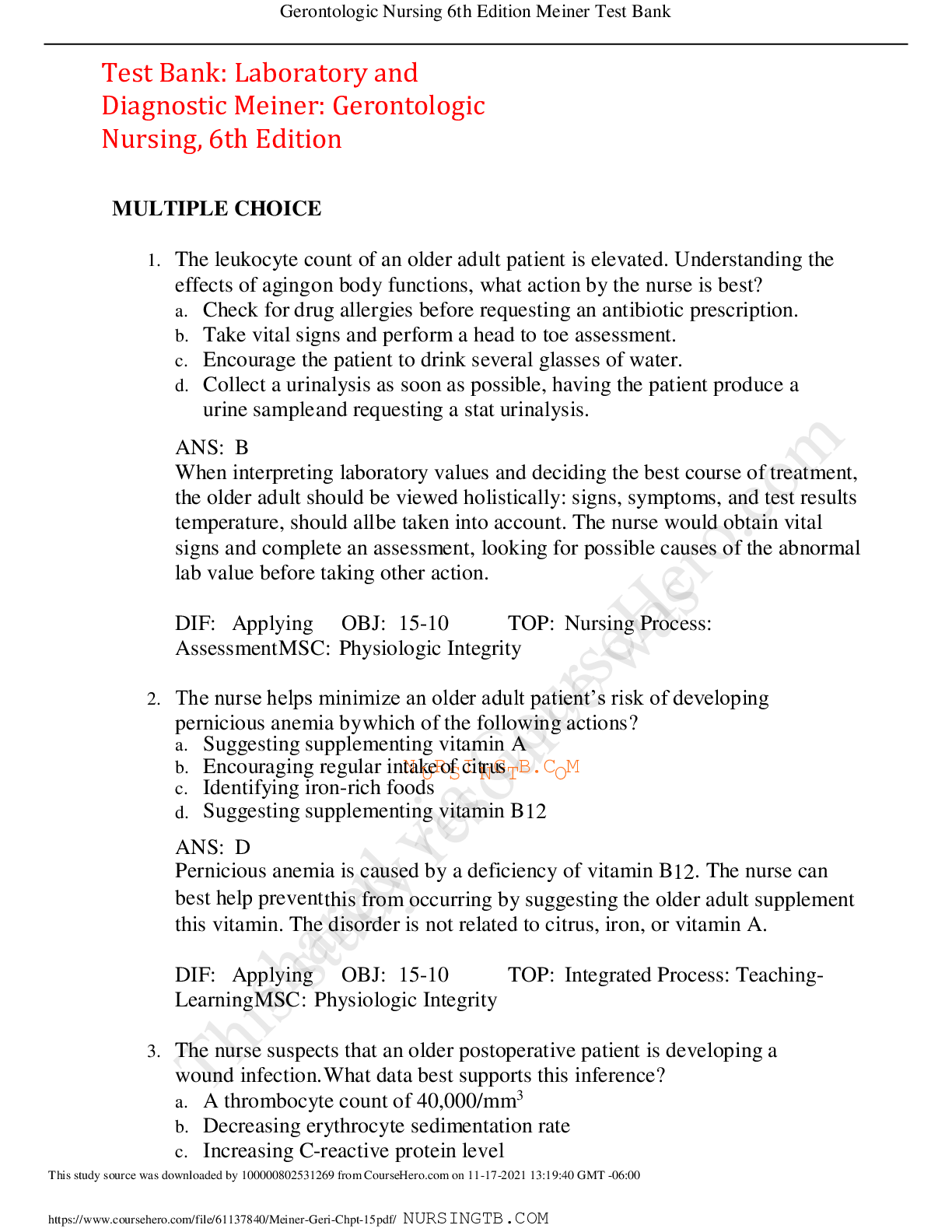


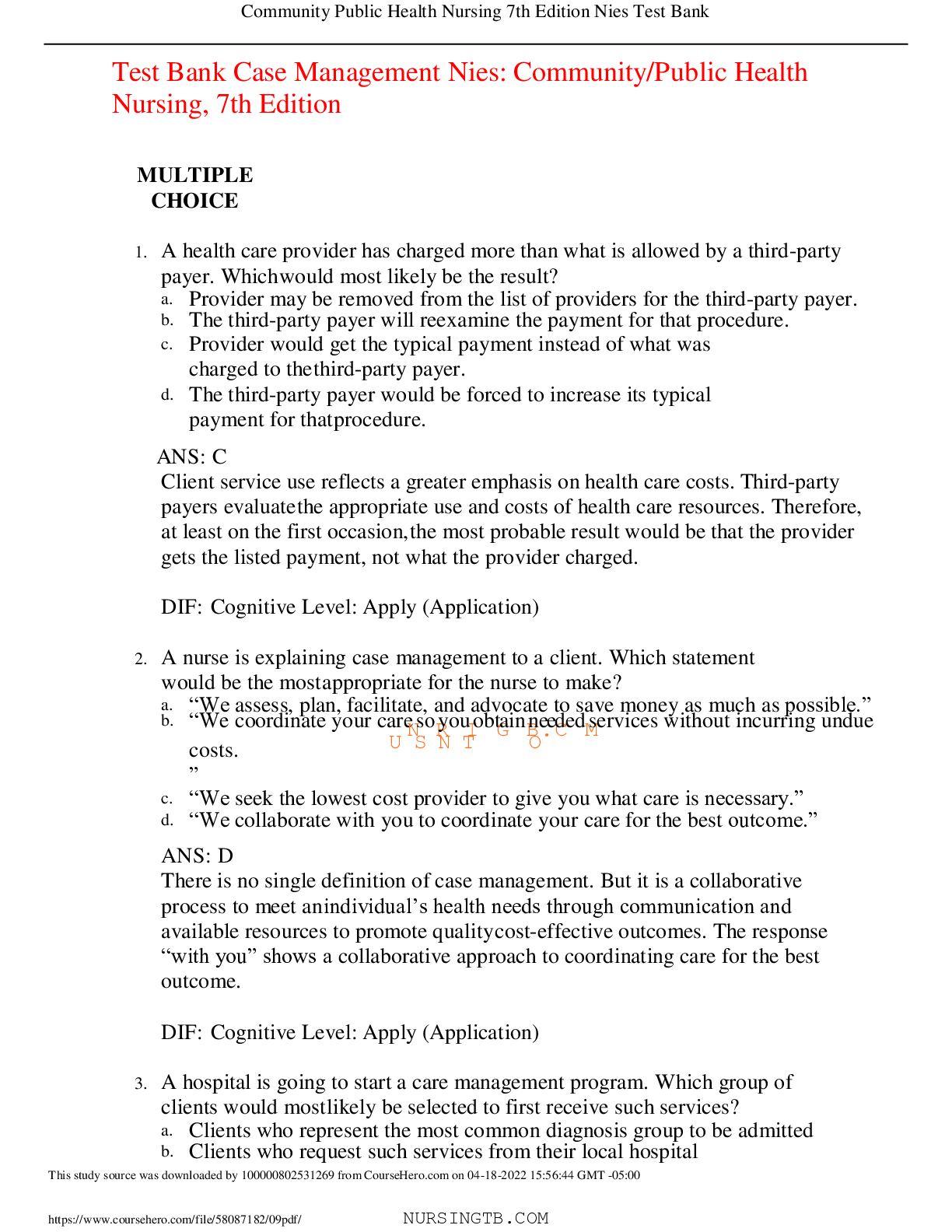


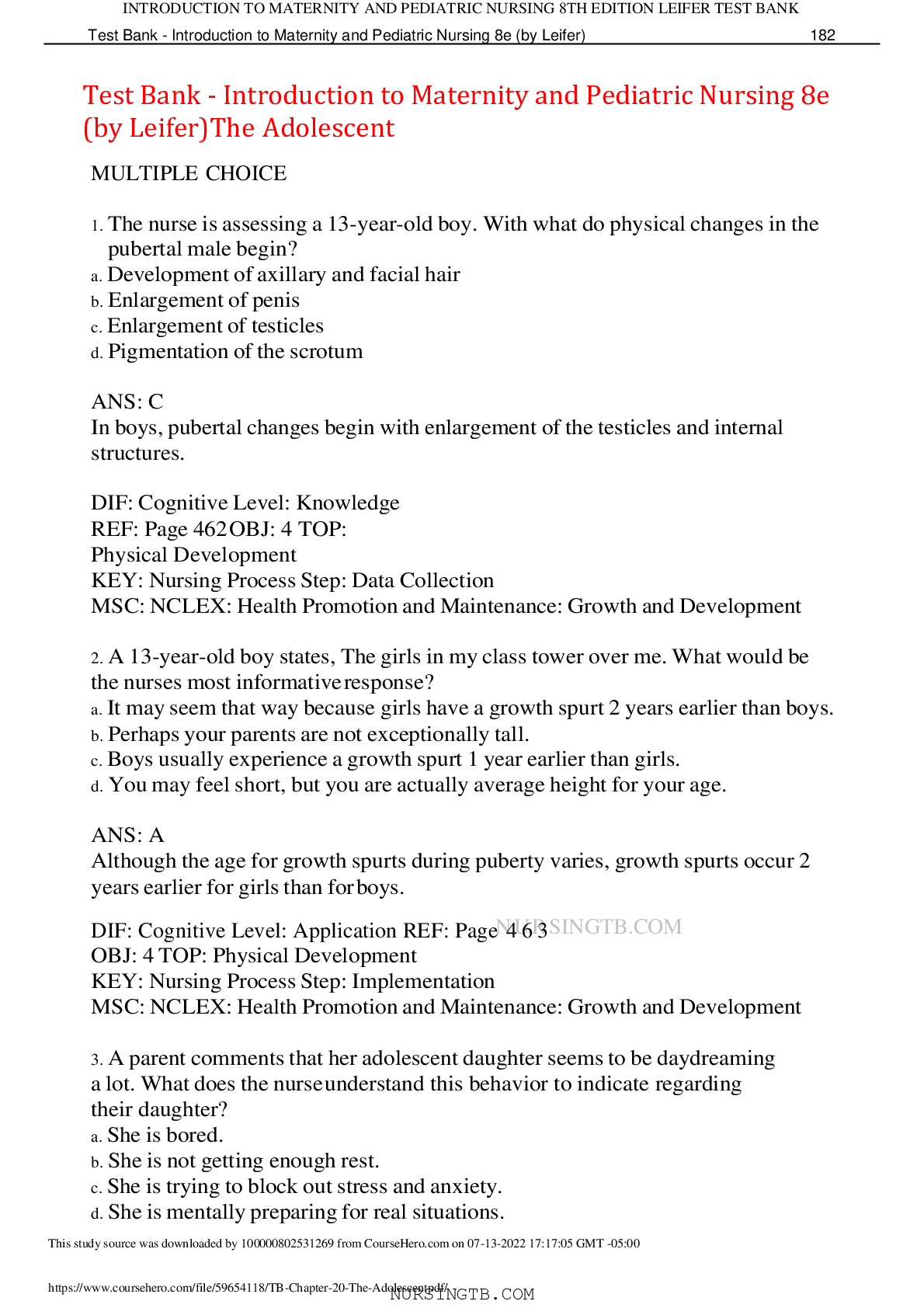
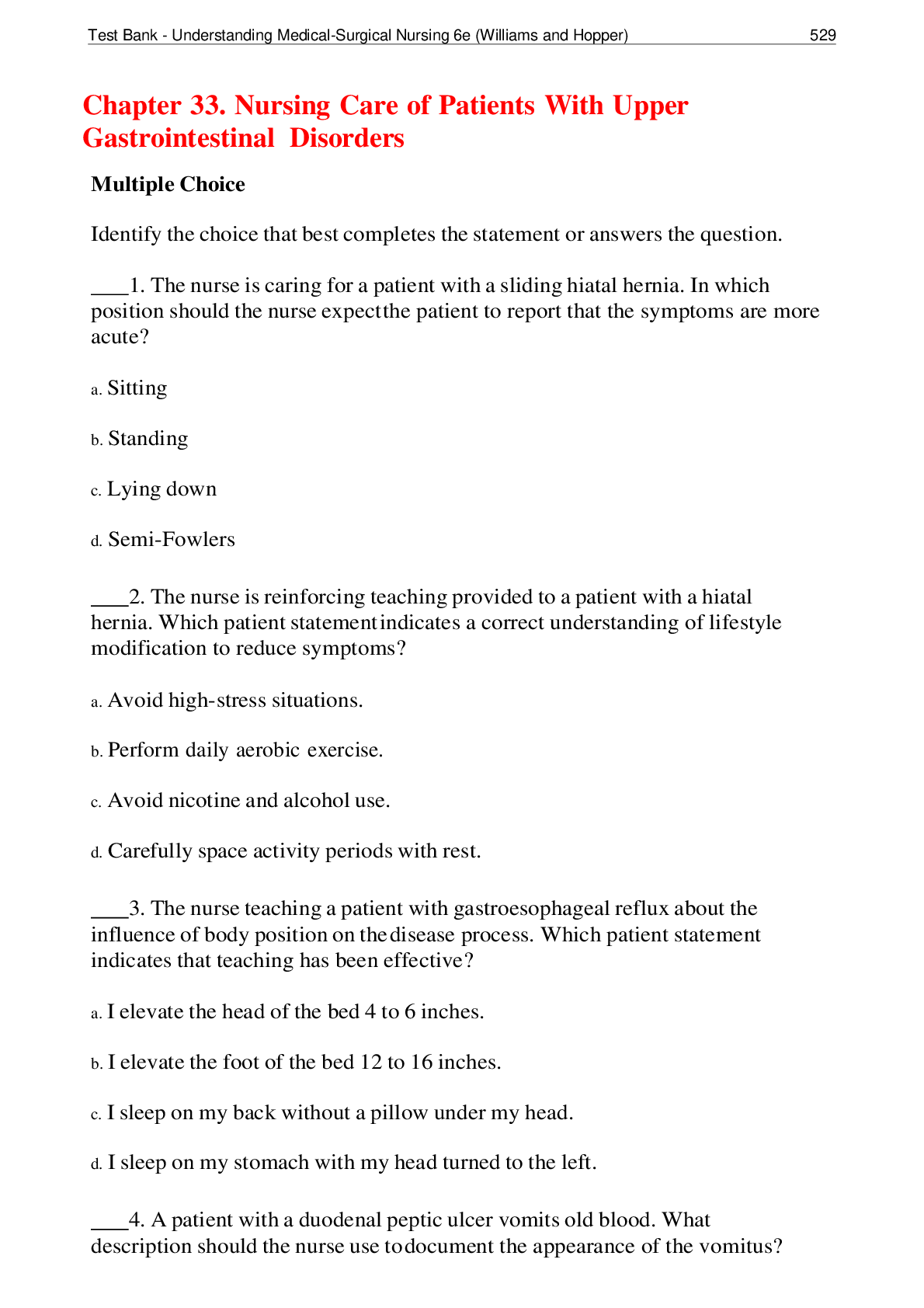
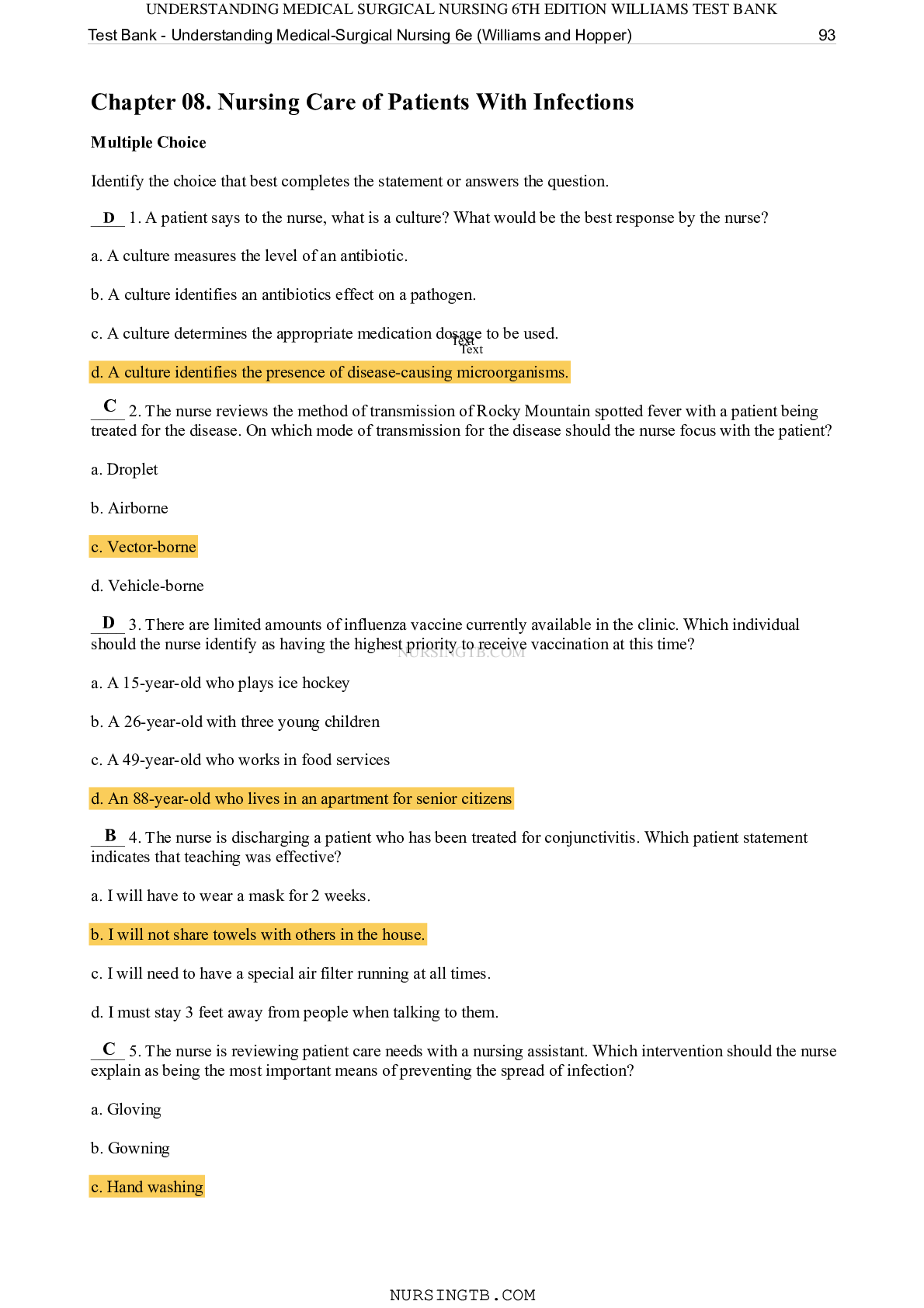
.png)
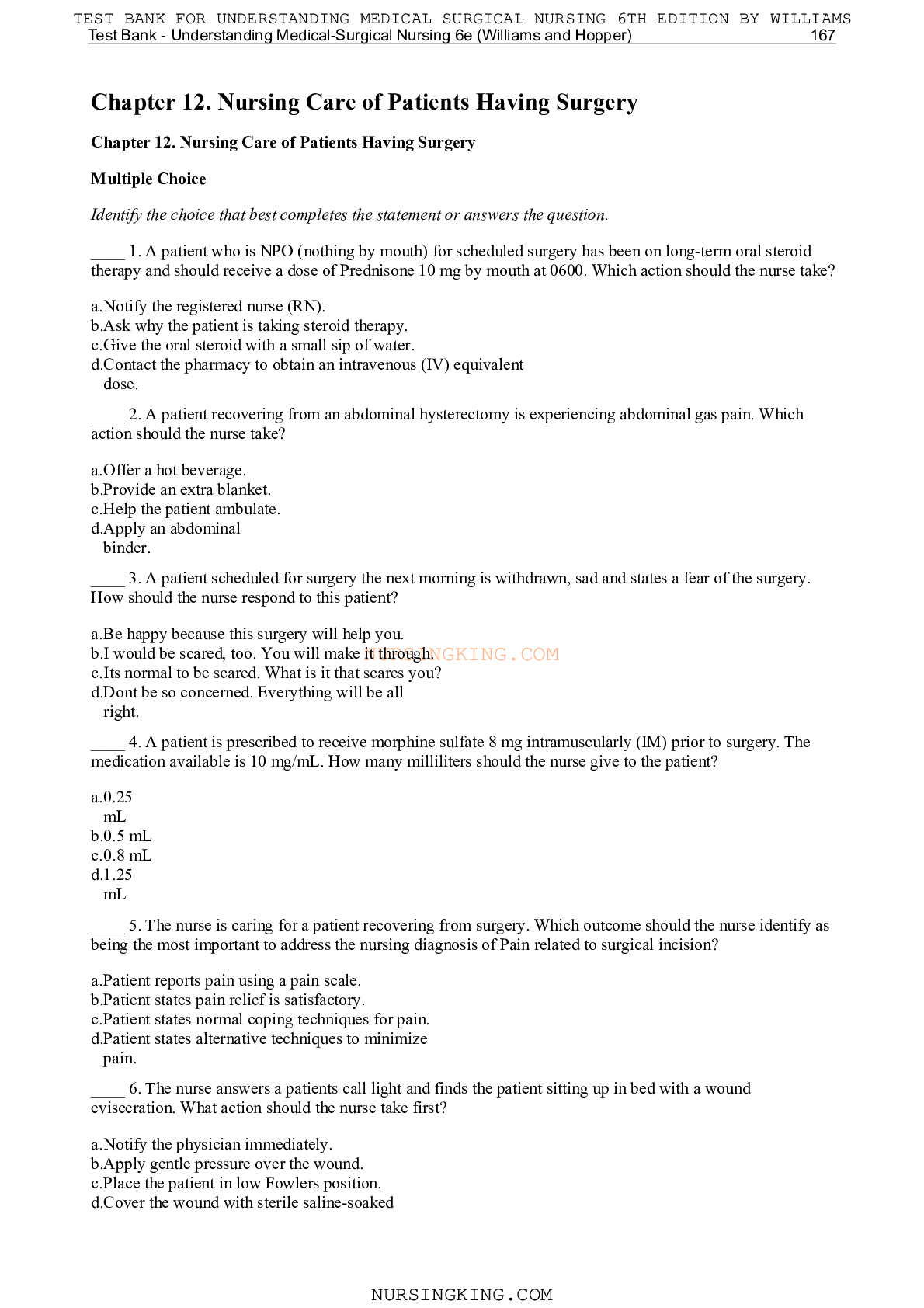
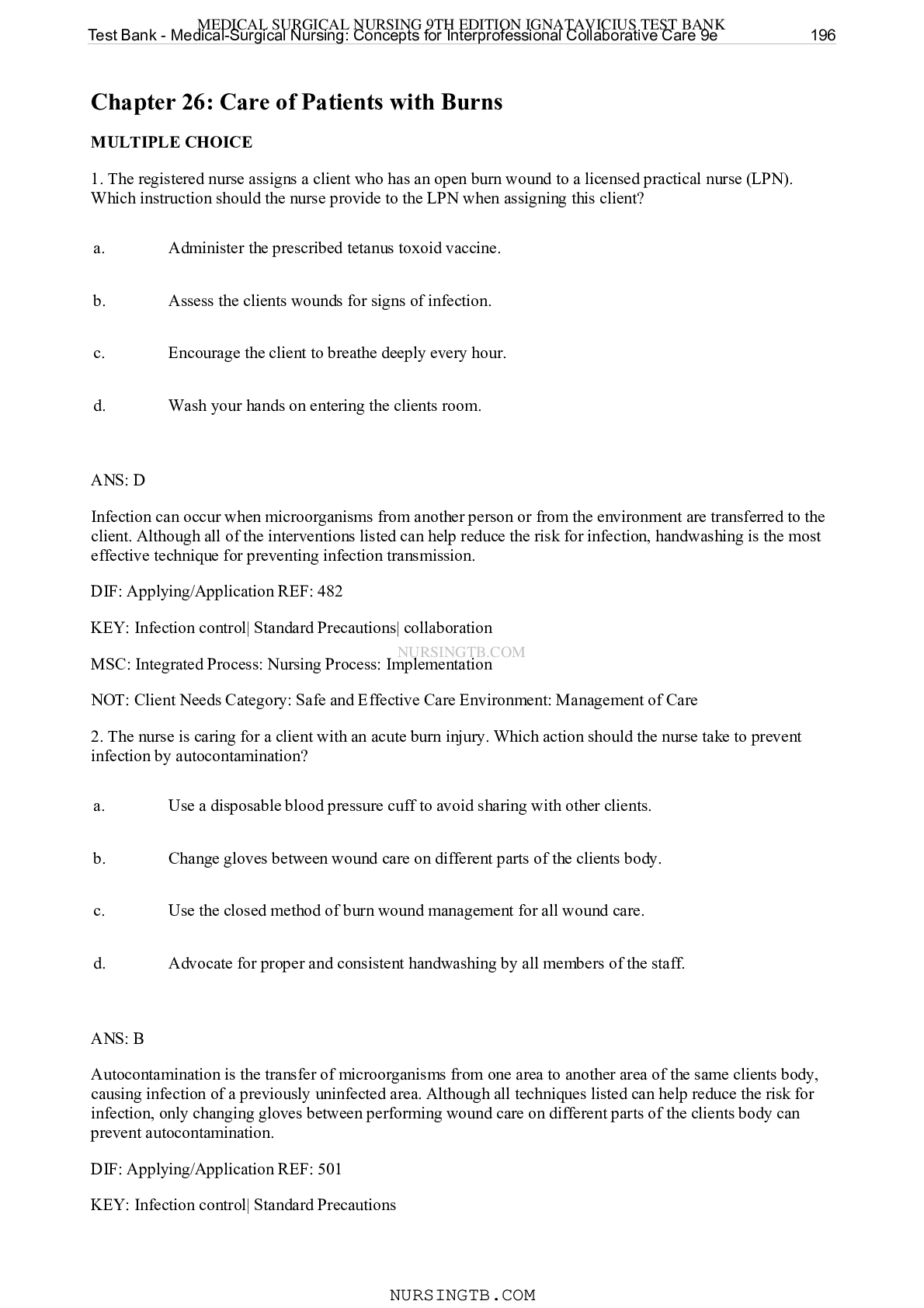



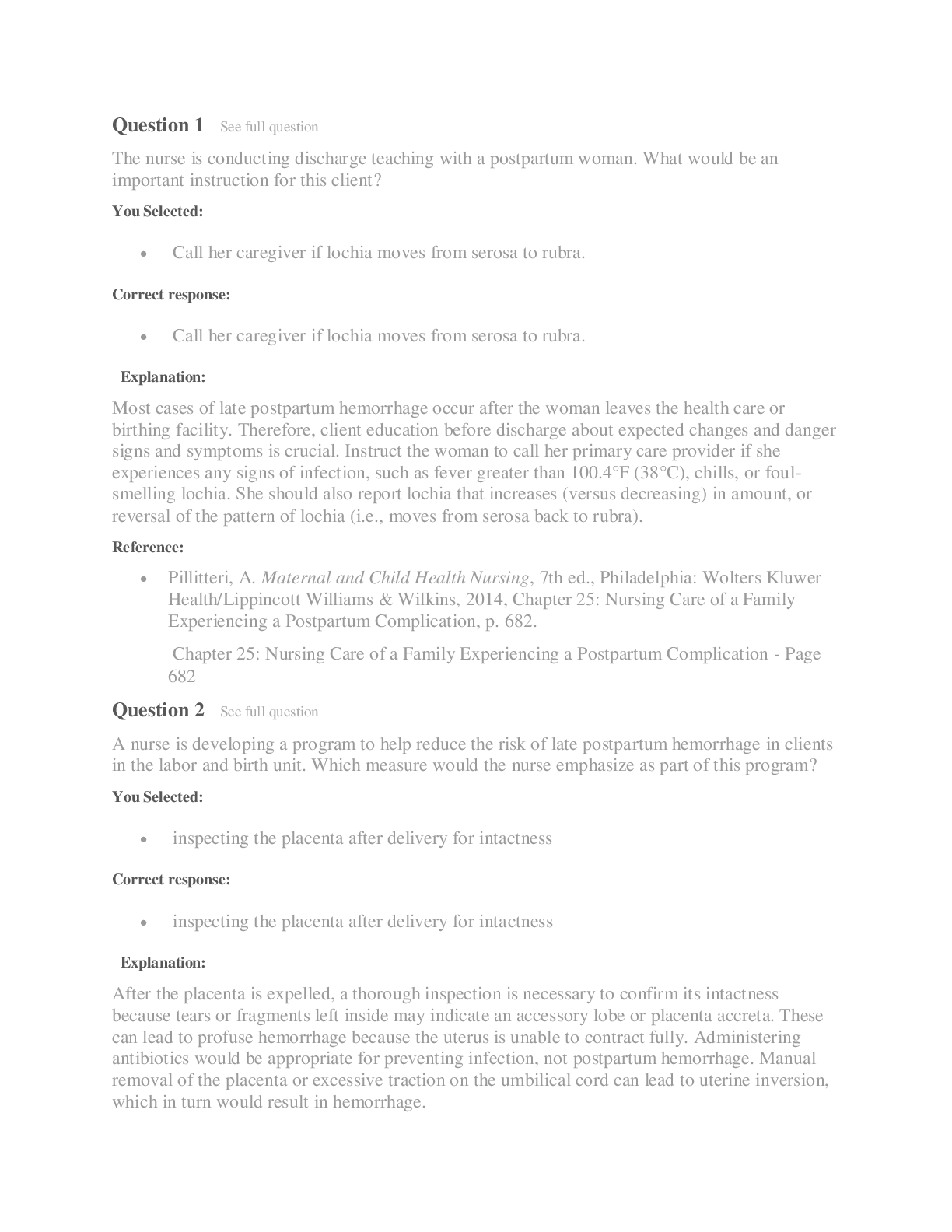

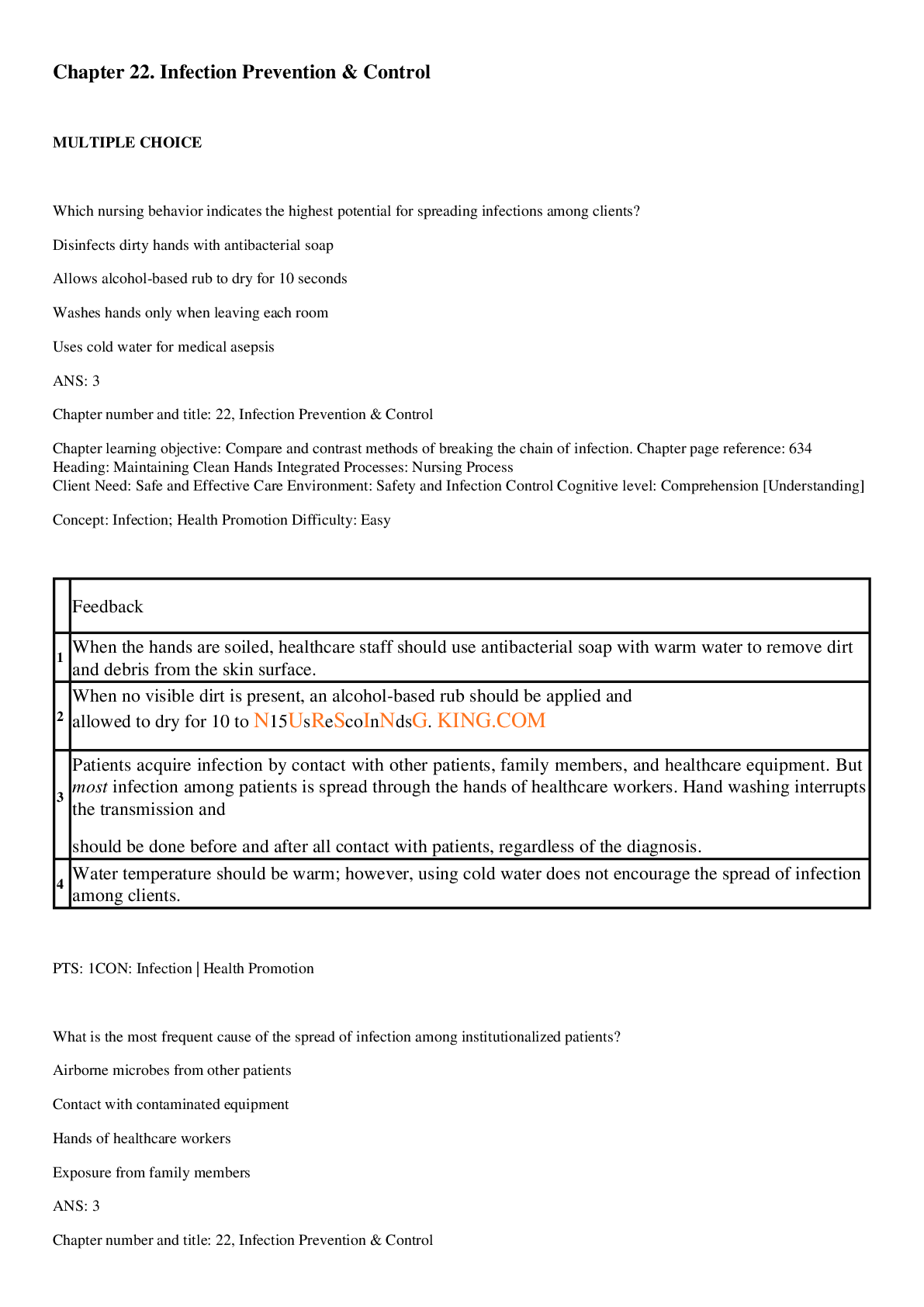
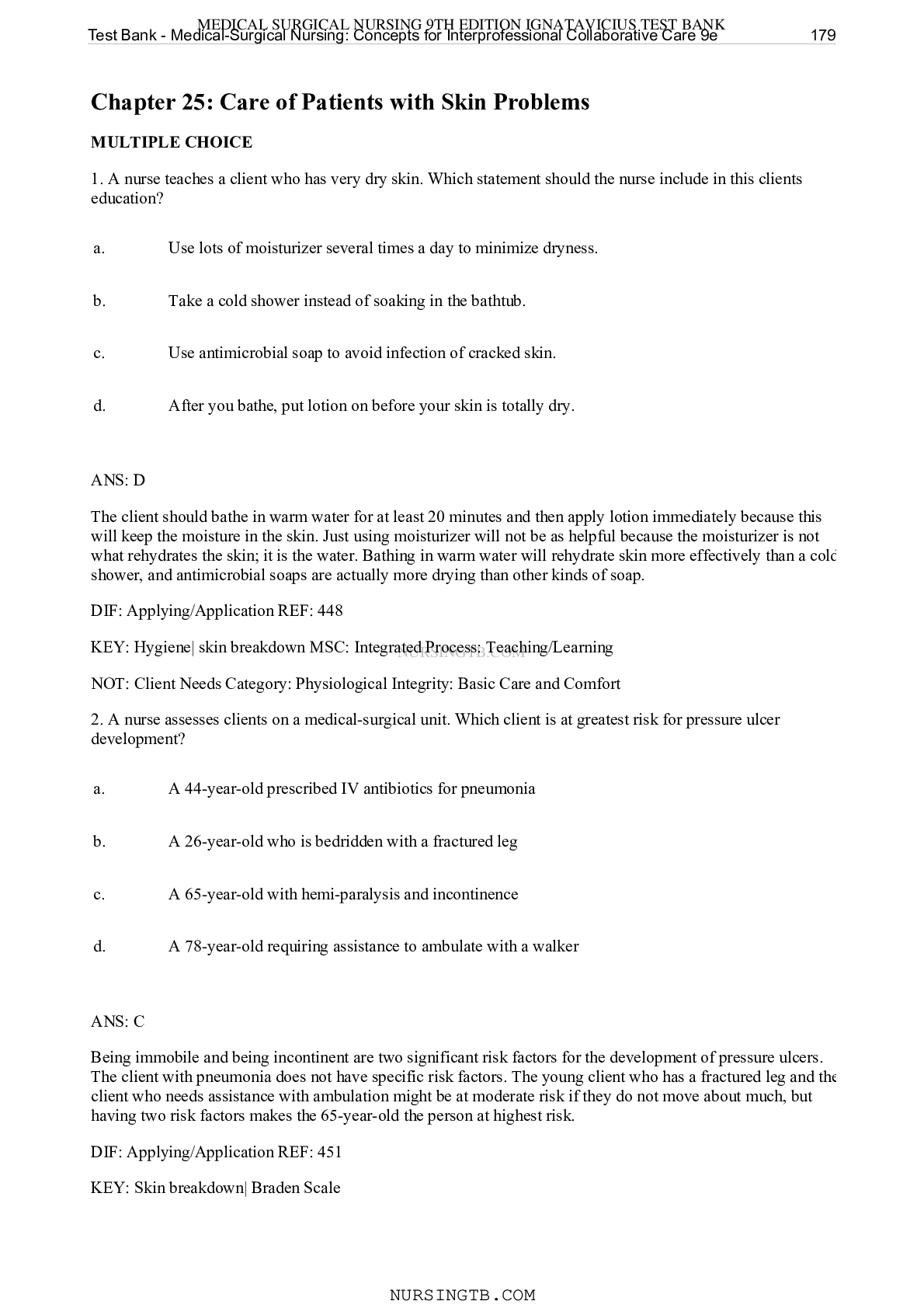

.png)

